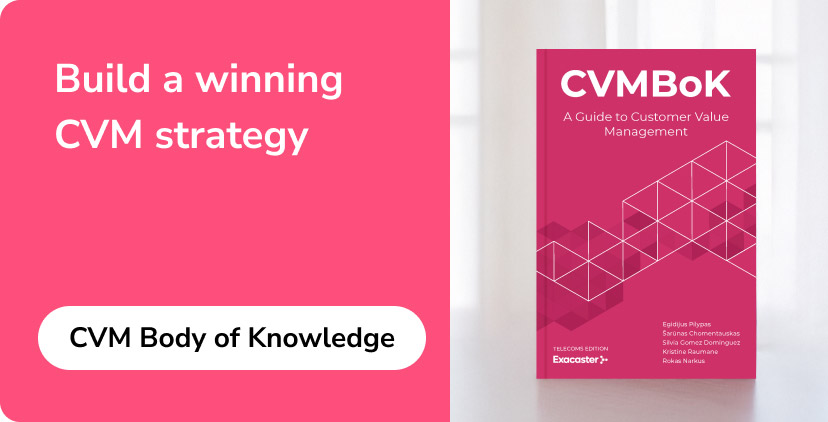The Era of Customer Value Management
Telecoms today face a new reality: the era of growth through rapid customer acquisition has ended as markets have matured globally. Now, sustainable growth hinges on retaining and maximizing the value of the existing customer base through effective customer value management (CVM). While competitors can quickly replicate products, pricing, and offers, they cannot copy the unique way you treat your customers, the value you create for them, and how you retain their loyalty. This is where CVM becomes critical.
Consider the experience of Alberto Arimana Celis, Head of B2B CVM at Entel Peru:

In 2019, when I began leading CVM in B2B at Entel Peru, our mobile churn rate was extremely high. I implemented significant changes—I restructured the organization, adjusted management focus, altered our approach with channels, and initiated weekly alignment meetings. We took ownership of customer communication; previously, no one did, and anyone could tell customers whatever they wanted. Through these efforts, over approximately two years, we reduced churn by 50 percent. It was an amazing achievement, and I’m proud of the huge work my team and I accomplished.
Telecoms are uniquely positioned to capitalize on CVM due to their mainly subscription-based business model, which offers distinct advantages:
• Continuously used product: Telecom services are used regularly and continuously. Unlike businesses that rely on one-time purchases, telecoms don’t need to constantly find new customers to survive. For example, an appliance manufacturer sells a washing machine, and the customer might not make another purchase for years. In contrast, telecom customers use voice, data, and messaging services daily. This continuous usage allows telecoms to focus on ensuring that existing customers renew their subscriptions or keep paying for prepaid service, enhancing the value with each renewal.
• Continuous relationship: Telecoms maintain ongoing relationships with customers, often spanning over a decade, with regular communication cycles. In contrast, a furniture retailer may only interact with a customer during the purchase and delivery of items. After that, the relationship largely ends unless the customer initiates another purchase. Telecoms, however, engage with customers through monthly billing, service updates, and support interactions, fostering deeper engagement and loyalty.
• Capability to analyze individual behaviors and needs: Subscription customers provide a wealth of data that can be individually analyzed. Telecoms can track usage patterns, preferences, and service needs at a granular level. Many businesses lack access to such detailed customer information. For example, a beverage company like Coca-Cola cannot determine how many individual servings a specific customer consumed last month or identify their most valuable consumers. Their products are sold through intermediaries, and direct consumption data is not accessible.
• Ownership of direct communication with customers: Telecoms have direct communication channels with their customers— through call centers, telemarketing, digital platforms like email and apps, and in-person interactions at retail stores. This direct connection is a significant advantage. Many companies do not have this level of access. For example, car manufacturers often rely on dealerships for sales and customer interactions. They may not communicate directly with car owners unless there’s a recall or service notification, limiting their ability to build relationships and offer personalized value.
These unique attributes create massive opportunities for growth through effective CVM. However, despite its potential, CVM is a relatively new and unstructured discipline. It is not taught in universities, and the number of CVM professionals is limited—approximately 3,000 to 4,000 globally—given that there are around 1,100 telecoms 15 worldwide with an average of three CVM professionals in each. Furthermore, CVM is commercially sensitive—professionals in the same country rarely share their knowledge, making it one of the best-kept secrets in marketing.
Our mission is to change this paradigm. We aim to help organizations grow by employing state-of-the-art CVM practices. We are committed to making CVM professionals famous and elevating the discipline to its rightful place in the strategic growth of telecoms.
Customer Value Management Body of Knowledge (CVMBoK)
As every CVM professional knows, there are no comprehensive resources to guide them in mastering this complex field. This Customer Value Management Body of Knowledge (CVMBoK) aims to fill the gap, serving as the definitive guide to navigating the intricacies of CVM in the telecom sector.
The CVMBoK is designed to empower you to:
• Strategically align your organization for CVM success: Learn how to position CVM within your organization to maximize its impact on customer retention and average revenue per user (ARPU) growth.
• Develop effective CVM programs: Gain insights into the full CVM programs portfolio that drives the impact in your organization and are aligned with customer needs.
• Build a robust CVM technology stack: Understand the technological infrastructure needed to support CVM operations, from customer data platforms to real-time decisioning systems.
• Foster cross-functional collaboration: Discover strategies to break down silos and collaborate effectively with departments like Marketing, Sales, IT, and Customer Service.

Let's make the CVM function famous! Share the CVMBoK with your peers, anyone interested in this topic, your management, and your cross-functional teams.
By delving into the CVMBoK, you’ll access actionable insights and best practices that address common challenges, such as siloed information, lack of standardized methodologies, and limited avenues for professional development. This unified framework is crafted by industry experts with decades of experience managing prepaid, postpaid, home services, and B2B customers.
Consider these reflections of fellow CVM practitioners:

Unfortunately, we don’t learn CVM at school. In the DRC [Democratic Republic of the Congo], there are no courses dedicated to CVM. You enter the industry and start working with data, trying to understand it and just sending out some offers. The recommended podcast is CVM Stories.

CVM is quite tough at the beginning because many practitioners don’t have a single source of information. You learn from data science, but there was no comprehensive book on CVM until Exacaster launched the CVMBoK digital version and started sharing insights in the CVM Stories podcast. Before this, my information came from reading data science books and trying to imagine how to implement it in our organization.
Our mission with the CVMBoK is clear: to elevate the discipline of CVM and support professionals like you in making a significant impact within your organizations. We aim to demystify CVM, provide the tools and knowledge necessary for success, and ultimately make CVM professionals renowned for their contributions to the telecom industry’s growth.
Next: How to Use This Guide
Now available on 12+ Amazon marketplaces
Learn from the best — CVMBoK book brings together knowledge from 30+ telecom CVM experts. Explore CVM Canvas, 10+ CVM programs, the latest technology and more. Get your CVMBoK book and stay ahead!





